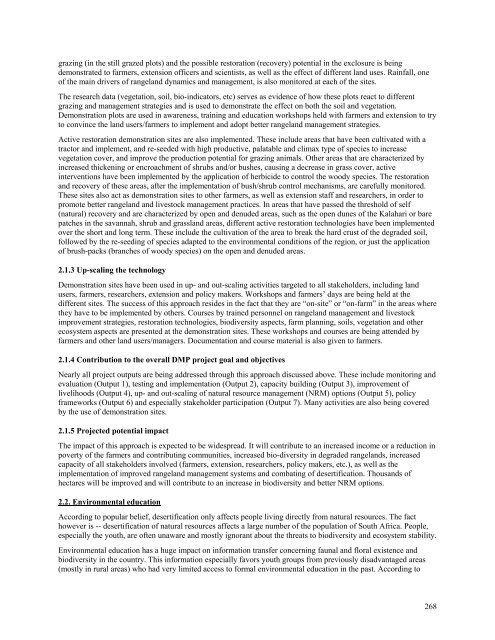ICRISAT Archival Report 2006 - The seedlings of success in the ...
ICRISAT Archival Report 2006 - The seedlings of success in the ...
ICRISAT Archival Report 2006 - The seedlings of success in the ...
You also want an ePaper? Increase the reach of your titles
YUMPU automatically turns print PDFs into web optimized ePapers that Google loves.
graz<strong>in</strong>g (<strong>in</strong> <strong>the</strong> still grazed plots) and <strong>the</strong> possible restoration (recovery) potential <strong>in</strong> <strong>the</strong> exclosure is be<strong>in</strong>g<br />
demonstrated to farmers, extension <strong>of</strong>ficers and scientists, as well as <strong>the</strong> effect <strong>of</strong> different land uses. Ra<strong>in</strong>fall, one<br />
<strong>of</strong> <strong>the</strong> ma<strong>in</strong> drivers <strong>of</strong> rangeland dynamics and management, is also monitored at each <strong>of</strong> <strong>the</strong> sites.<br />
<strong>The</strong> research data (vegetation, soil, bio-<strong>in</strong>dicators, etc) serves as evidence <strong>of</strong> how <strong>the</strong>se plots react to different<br />
graz<strong>in</strong>g and management strategies and is used to demonstrate <strong>the</strong> effect on both <strong>the</strong> soil and vegetation.<br />
Demonstration plots are used <strong>in</strong> awareness, tra<strong>in</strong><strong>in</strong>g and education workshops held with farmers and extension to try<br />
to conv<strong>in</strong>ce <strong>the</strong> land users/farmers to implement and adopt better rangeland management strategies.<br />
Active restoration demonstration sites are also implemented. <strong>The</strong>se <strong>in</strong>clude areas that have been cultivated with a<br />
tractor and implement, and re-seeded with high productive, palatable and climax type <strong>of</strong> species to <strong>in</strong>crease<br />
vegetation cover, and improve <strong>the</strong> production potential for graz<strong>in</strong>g animals. O<strong>the</strong>r areas that are characterized by<br />
<strong>in</strong>creased thicken<strong>in</strong>g or encroachment <strong>of</strong> shrubs and/or bushes, caus<strong>in</strong>g a decrease <strong>in</strong> grass cover, active<br />
<strong>in</strong>terventions have been implemented by <strong>the</strong> application <strong>of</strong> herbicide to control <strong>the</strong> woody species. <strong>The</strong> restoration<br />
and recovery <strong>of</strong> <strong>the</strong>se areas, after <strong>the</strong> implementation <strong>of</strong> bush/shrub control mechanisms, are carefully monitored.<br />
<strong>The</strong>se sites also act as demonstration sites to o<strong>the</strong>r farmers, as well as extension staff and researchers, <strong>in</strong> order to<br />
promote better rangeland and livestock management practices. In areas that have passed <strong>the</strong> threshold <strong>of</strong> self<br />
(natural) recovery and are characterized by open and denuded areas, such as <strong>the</strong> open dunes <strong>of</strong> <strong>the</strong> Kalahari or bare<br />
patches <strong>in</strong> <strong>the</strong> savannah, shrub and grassland areas, different active restoration technologies have been implemented<br />
over <strong>the</strong> short and long term. <strong>The</strong>se <strong>in</strong>clude <strong>the</strong> cultivation <strong>of</strong> <strong>the</strong> area to break <strong>the</strong> hard crust <strong>of</strong> <strong>the</strong> degraded soil,<br />
followed by <strong>the</strong> re-seed<strong>in</strong>g <strong>of</strong> species adapted to <strong>the</strong> environmental conditions <strong>of</strong> <strong>the</strong> region, or just <strong>the</strong> application<br />
<strong>of</strong> brush-packs (branches <strong>of</strong> woody species) on <strong>the</strong> open and denuded areas.<br />
2.1.3 Up-scal<strong>in</strong>g <strong>the</strong> technology<br />
Demonstration sites have been used <strong>in</strong> up- and out-scal<strong>in</strong>g activities targeted to all stakeholders, <strong>in</strong>clud<strong>in</strong>g land<br />
users, farmers, researchers, extension and policy makers. Workshops and farmers’ days are be<strong>in</strong>g held at <strong>the</strong><br />
different sites. <strong>The</strong> <strong>success</strong> <strong>of</strong> this approach resides <strong>in</strong> <strong>the</strong> fact that <strong>the</strong>y are “on-site” or “on-farm” <strong>in</strong> <strong>the</strong> areas where<br />
<strong>the</strong>y have to be implemented by o<strong>the</strong>rs. Courses by tra<strong>in</strong>ed personnel on rangeland management and livestock<br />
improvement strategies, restoration technologies, biodiversity aspects, farm plann<strong>in</strong>g, soils, vegetation and o<strong>the</strong>r<br />
ecosystem aspects are presented at <strong>the</strong> demonstration sites. <strong>The</strong>se workshops and courses are be<strong>in</strong>g attended by<br />
farmers and o<strong>the</strong>r land users/managers. Documentation and course material is also given to farmers.<br />
2.1.4 Contribution to <strong>the</strong> overall DMP project goal and objectives<br />
Nearly all project outputs are be<strong>in</strong>g addressed through this approach discussed above. <strong>The</strong>se <strong>in</strong>clude monitor<strong>in</strong>g and<br />
evaluation (Output 1), test<strong>in</strong>g and implementation (Output 2), capacity build<strong>in</strong>g (Output 3), improvement <strong>of</strong><br />
livelihoods (Output 4), up- and out-scal<strong>in</strong>g <strong>of</strong> natural resource management (NRM) options (Output 5), policy<br />
frameworks (Output 6) and especially stakeholder participation (Output 7). Many activities are also be<strong>in</strong>g covered<br />
by <strong>the</strong> use <strong>of</strong> demonstration sites.<br />
2.1.5 Projected potential impact<br />
<strong>The</strong> impact <strong>of</strong> this approach is expected to be widespread. It will contribute to an <strong>in</strong>creased <strong>in</strong>come or a reduction <strong>in</strong><br />
poverty <strong>of</strong> <strong>the</strong> farmers and contribut<strong>in</strong>g communities, <strong>in</strong>creased bio-diversity <strong>in</strong> degraded rangelands, <strong>in</strong>creased<br />
capacity <strong>of</strong> all stakeholders <strong>in</strong>volved (farmers, extension, researchers, policy makers, etc.), as well as <strong>the</strong><br />
implementation <strong>of</strong> improved rangeland management systems and combat<strong>in</strong>g <strong>of</strong> desertification. Thousands <strong>of</strong><br />
hectares will be improved and will contribute to an <strong>in</strong>crease <strong>in</strong> biodiversity and better NRM options.<br />
2.2. Environmental education<br />
Accord<strong>in</strong>g to popular belief, desertification only affects people liv<strong>in</strong>g directly from natural resources. <strong>The</strong> fact<br />
however is -- desertification <strong>of</strong> natural resources affects a large number <strong>of</strong> <strong>the</strong> population <strong>of</strong> South Africa. People,<br />
especially <strong>the</strong> youth, are <strong>of</strong>ten unaware and mostly ignorant about <strong>the</strong> threats to biodiversity and ecosystem stability.<br />
Environmental education has a huge impact on <strong>in</strong>formation transfer concern<strong>in</strong>g faunal and floral existence and<br />
biodiversity <strong>in</strong> <strong>the</strong> country. This <strong>in</strong>formation especially favors youth groups from previously disadvantaged areas<br />
(mostly <strong>in</strong> rural areas) who had very limited access to formal environmental education <strong>in</strong> <strong>the</strong> past. Accord<strong>in</strong>g to<br />
268

















